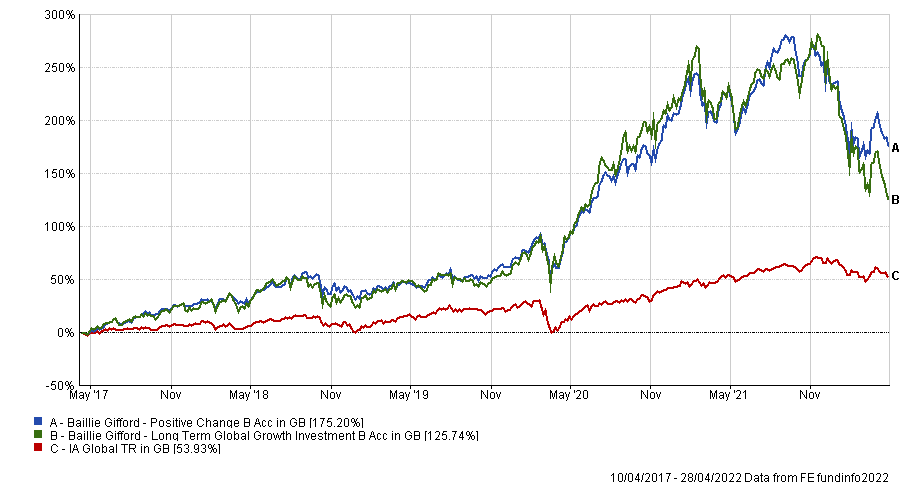Baillie Gifford released the Long Term Global Growth Investment and Positive Change funds three months apart from each other in 2017 and performance has broadly mirrored since.
The Positive Change portfolio outperformed with a total return of 144.1% while Long Term Global Growth Investment trailed slightly behind at 123.5%. Likewise, the assets under management (AUM) of each fund are similar, with Long Term Global Growth Investment at £2.7bn and Positive Change at £2.6bn.
Trustnet found that 10 stocks make up more than 25% of allocations in Baillie Gifford’s 10 biggest portfolios, suggesting that investors only need to hold one in their portfolios without an overlap.
This is also true with the Long Term Global Growth Investment and Positive Change portfolios, which have the same assets in half of their top 10 holdings.
Investors looking for exposure to the IA Global sector may be left confused as to which fund to go for, so Trustnet asked experts what portfolio is better positioned to outperform.
Total return of funds vs sector since launch

Source: FE Analytics
Sam Buckingham, investment analyst at Kingswood said that while both possess a similar investment philosophy, with a sharp focus on high-growth companies, he favours the Positive Change portfolio.
Its environmental, social and governance (ESG) mandate means that assets are more diversified across different regions and sectors, according to Buckingham.
He said: “Positive Change has had significantly lower volatility and protected better in sell-offs, whilst still generating higher returns long-term.”
This was echoed by Charlie Parker, managing director of Albemarle Street Partners who said that Long Term Global Growth Investment’s exposure to large US tech companies put it at a disadvantage.
Growth stocks have performed extraordinarily well over the past decade, but new pressures placed on companies by the war in Ukraine and aftermath of Covid have led to a rotation towards value.
As a result, the IA Technology and Technology Innovations sector is down 18% since the start of the year, dropping to the bottom quartile over the past year after being the top performer for the past decade.
The same can be said for the IA North America sector which dropped 5.9% this year due to its dependence on large technology companies.
Total return of sectors since the start of the year

Source: FE Analytics
Parker added: “We see the individual position sizing in the Long Term Growth Investment fund to be very punchy – therefore investors in this fund should be prepared for short- to medium-term underperformance.
“Those periods of underperformance are likely to be associated with periods like the current one – because when inflation rises, the most expensive companies will fall the most in that environment.”
On the flip side of that, Parker pointed out that the Long Term Global Growth Investment’s growth bias means it is more likely to perform well when in inflation is low.
For the time being, inflation is rampant and rising at a rapid rate, with Thomas Becket, chief investment officer at Punter Southall Wealth predicting that this difficult environment will persist for much of the next decade.
While Positive Change is his favoured option, Buckingham said that Long Term Global Growth’s less concentrated holdings could be a benefit to the fund over time – it has 44 holdings compared to 37 in the Positive Change portfolio.
He said: “We believe managing position sizes is paramount, particularly in the high growth space where share prices can be punished for disappointing/slowing earnings, as indicated by Netflix’s fall of 35% on 20th April 2022.”
Dean Barnard, senior investment analyst at City Asset Management added that although Positive Change’s ESG aspect is a key differentiator, Long Term Global Growth Investment’s broader allocations makes it a more attractive long-term option.
He also said that “it is competitively priced and should provide some correlation benefits in a diversified portfolio along-side more valuation sensitive strategies.”





